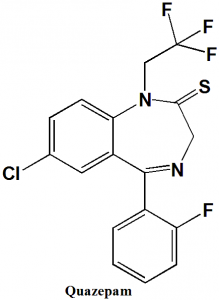QUAZEPAM Synthesis, SAR, MCQ,Structure,Chemical Properties and Therapeutic Uses
Quazepam
IUPAC nomenclature
7-chloro-5-(2-fluorophenyl)-1-(2,2,2-trifluoroethyl)-3H-1,4-benzodiazepine-2-thione
Classification
Quazepam is a benzodiazepine sedative-hypnotic.
Physiochemical Properties
| S. NO. | PHYSICAL AND CHEMICAL PROPERTIES | |
| 1 | Molecular weight | 386.8 g/mol |
| 2 | Physical appearance | Solid |
| 3 | Melting point | 137.5-139°C |
| 4 | Octanol/water partition coefficient | 4.03 |
| 5 | Solubility | 2.31e-03 g/L |
| 6 | Presence of ring | Diazepine, benzene |
| 7 | Number of chiral centers | 1 |
Mechanism of Action
i. Quazepam binds nonspecifically with benzodiazepine receptors BNZ1.
ii. It coupled with GABAA receptors and increases the GABA affinity for the GABA receptor.
iii. This results in opening of the chloride channel and thus, causes hyperpolarization of the cell membrane which prevents further excitation of the cell.
Structure Activity Relationship
- Ring A should include an aromatic or heteroaromatic ring for binding with 5-phenyl-1,4-benzodiazepin-2-one derivatives.
- An electronegative group at 7-position of the ring A increases the functional anxiolytic activity.
- Substitutions at 6, 8 or 9 position with electronegative group on ring A will decrease the functional anxiolytic activity.
- When Heterocycles used as ring A, drug shows poor pharmacological activity.
- A proton-accepting group is essential on Ring B for binding with GABAA
- When the proton accepting group is present on the 2-position of the ring B, and is in coplanar spatial orientation with Ring A, maximum activity is observed.
- Replacement of oxygen with sulfur in ring B results in alteration in the selectivity for binding with GABA BZR subpopulations, but anxiolytic properties are maintained.
- There is no effect on agonist activity, but the antagonist activity dereases when methylene 3-position or imine nitrogen of the ring B is substituted.
- Derivatives having the 3-hydroxy moiety are fast excreted.
- Sterically large substituents on ring B, like tert-butyl group reduces the receptor affinity and the in vivo activity.
- 4,5-double bond and 4-position nitrogen is not essential for anxiolystic activity.
- BZR affinity is decreased if C=N bond is replaced with C-N bond.
- 5-phenyl ring C is not necessary for the binding with BZR.
- Substitution at the para position of the ring C decreases the agonist activity of the drug.
- There is no change observed in the agonist property of the drug when there is substitution at ortho position.
- When 1,2-bond f the ring C is annelated with an additional electron rich ring such as imidazole, affinity of the BZR increases. [1]
Method of synthesis
i. (2-amino-5-chlorophenyl)(2-fluorophenyl)methanone reacts with 2,2,2-trifluoroethyl trichloromethanesulfonate to give (2-(2,2,2-trifluoroethylamino)-5-chlorophenyl) (2-fluorophenyl)methanone.
ii. Compound reacts with 2-bromoacetylchloride followed by reaction with isoindoline-1,3-dione and hydrazine to give an unstable compound which on further reaction with phosphorus pentasulfide give quazepam.
Therapeutic Uses
Quazepam is used for:
- Treatment of insomnia
Side Effects
Side effects of Quazepam are:
- Dizziness
- Memory loss
- Hallucinations
- Confusion
- Mood changes
- Anxiety
- Aggressive behavior
- Loss of coordination
- Blurred vision
MCQ
Q.1 Correct statements related with the physicochemical properties of drug quazepam?
I. Molecular weight = 386.8 gm/mol
II. Physical appearance: Solid
III. Melting point: 137K
IV. Triazole ring present
a) I, III
b) II, IV
c) I, II
d) I, II, IV
Q.2 Match the following of the drugs with their correct IUPAC names.
| i. Quazepam | A. 8-chloro-6-phenyl-4H-[1,2,4]triazolo[4,3-a][1,4]benzodiazepine |
| ii. Epinephrine | B. 7-chloro-5-(2-fluorophenyl)-1-(2,2,2-trifluoroethyl)-3H-1,4-benzodiazepine-2-thione
|
| iii. Norepinephrine | C. (R)-4-(2-amino-1-hydroxyethyl)benzene-1,2-diol |
| iv. Estazolam | D. (R)-4-(1-Hydroxy-2-(methylamino)ethyl)benzene-1,2-diol
|
a) i-B, ii-C, iii-A, iv-D
b) i-A, ii-C, iii-B, iv-D
c) i-D, ii-A, iii-C, iv-B
d) i-B, ii-D, iii-C, iv-A
Q.3 Correct steps for the mechanism of action of the drug Quazepam?
I. Binds with BNZ1 receptors
II. Increase in GABA affinity for GABA receptors
III. Opening of chloride channel
IV. Hyperpolarisation
a) I – II – III – IV
b) II – I – III – IV
c) III – I – II – IV
d) II – IV – III – I
Q.4 Correct sequence for True/false for the classification of the drug can be?
- Quazepam: benzodiazepine sedative-hypnotic
- Quetipine : benzodiazepine sedative-hypnotic
- Flurazepam: benzapenes
- Eszopiclone: butyrophenone
a) TFTF
b) FFTF
c) TFFF
d) FTFT
Q.5 Introduction of the electronegative group at 7-position of the ring A of drug quazepam leads to?
a) Decrease in lipophyllicity
b) Increase in lipophyllicity
c) Increase in anxiolytic property
d) Decrease in anxiolytic property
Q.6 The correct sequence for the steps for synthesis of drug quazepam from (2-amino-5-chlorophenyl)(2-fluorophenyl)methanone is?
I. Reaction with isoindolin-1,3-dione and hydrazine
II. Reaction with phosphorous pentasulfde
III. Reaction with 2-bromo aetylchloride
IV. Reaction with 2,2,2-trifluoroethyl trichloromethylsulfonate
a) IV – III – I – II
b) I – II – III – IV
c) I – III – IV – II
d) IV- II – III –I
Q.7 Side effect of drug quazepam?
a) Anxiety
b) Loss of coordination
c) Blurred vision
d) All of the above
Participate in Free Online Test for GPAT
Participate in Online FREE Pharmacist TEST: CLICK HERE
Participate in Online FREE Drug Inspector TEST: CLICK HERE
ANSWERS
1-c
2-d
3-a
4-c
5-c
6-a
7-d
REFERENCES
[1] Lemke TL, Zito SW, Roche VF, Williams DA. Essentials of Foye’s principles of medicinal chemistry. Wolters Kluwer; 2017, 473-474.

